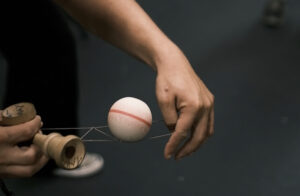
Austin Donovan encountered a kendama for the first time when he was 14 years old in 2008. A friend in his art class took one to school and attracted a line of people who wanted to try a basic trick on this traditional Japanese wooden toy. Everyone, except for Donovan, just stared at the line with no intention of joining.
“That thing is stupid,” he thought to himself. “Keep me away from that.”
Later that day, Donovan was eventually convinced by his friend to buy a kendama so they could play together. They watched all the trick videos available online that afternoon. The boy with zero fascination for the ball-and-cup toy soon became obsessed. Soon, he’d become a kendama legend.
Kendama made its debut in the United States in 2007, but it only gained popularity in recent years. According to Ken Docs, a kendama documentation website, 141 professional kendama players currently play in the country, and that number is growing. Nationwide, kendama jams and competitions are held to spread the love and philosophy of the toy, and New York City is the epicenter of the game.

Donovan, 28 years old, spent seven years playing the kendama alone without knowing other players before he met player Bonz Atron, the kendama world champion at the time, who hosted a jam in Times Square in 2015.
“Immediately after playing with other like-minded individuals, it was like a spark in my brain,” Donovan said. After finding other players, Donovan joined the first kendama community in New York City: KENYC.
Donovan is now the longest-serving kendama player in the country, and he has an active love for kendama. A kind of love that pushes him to do anything that he can do to help push the community. Not only a player, but also as a sensei (or master in Japanese), he described kendama as one of the most inclusive things he had ever encountered.
“I have been able to go to schools and teach 3-year-old children with disabilities how to play, and [they] get stoked on kendama,” Donovan said while showing the string trick on kendama that he is well-known for. “I have seen 90-year-old elderly people in wheelchairs use kendama to help with their arthritis. Donovan controlled the string while the Tama and the ken flowed around, making numerous turns that were difficult to catch by the naked eye.

When not playing, players hang the kendama around their necks, which becomes a tacit sign between players. Isaac Turner, 28, once met a player at Yosemite National Park, and they hugged just because they saw kendama around each other’s neck.
After playing kendama for four years, Turner founded his online kendama store in 2019 known as Lotus Kendama. The lotus flower conveys a sense of peace and Zen, which is also the sense that kendama brings to Turner. He sees kendama as a tool to help people stay away from technology.
“When you’re playing kendama, you are concentrated on two wooden objects that are completely infiltrated by gravity— there’s no technology, no batteries,” said Turner staring at the kendama in his hand. “It’s just complete nature.”
Donovan answered almost without hesitation when asked why players would get so enchanted by this wooden skill toy. “Kendama, this piece of what has been the best teacher in my entire life.” He describes kendama as his “Sensei”–a word that could refer to a person but also to anything one could learn something from; Kendama, in this case, is the sensei. “Kendama teaches me how to progress,” said Donovan.

Donovan put his phone on the ground to record himself practicing a trick at a jam in Williamsburg. He missed a few times, but did not give up trying. Eventually, he got the Tama into the spike. As a skill toy, players will fail numerous attempts before completing a trick, but they train their minds to think about and improve from the mistakes they made during each attempt.
“If you do that on every single attempt and consciously think about every attempt, that’ll naturally become your thought process when playing kendama,” Donovan said. “It will become a natural thought process in everyday life.”

While showing a classic kendama trick, the lighthouse, in which the bottom cup of the Ken is balanced above the Tama— Turner talked about how people could turn impossibilities into possibilities by putting more effort and practice. “Your sense of impossibility doesn’t really dictate what you can and cannot do,” said Turner while concentrating on keeping Ken balanced on the Tama.
Seeing the philosophy of kendama, Shneur Fomin, a 29-year-old kendama player and gym teacher at the Williamsburg High School of Arts and Technology, decided to introduce the toy to his school. “I wanted [Donovan] to come for a two day workshop and to give us 100 kendamas, which they did.”
This is the second year Fomin is putting kendama into his teaching plan. “I can tell a lot of students really appreciated it and really enjoyed being a part of that,” he said.

But players want kendama to be more than a popular toy. For Donovan, this could just be the beginning of its popularity. In fact, the leaders of the global network of kendama are in talks with the Olympic Committee to bring this traditional Japanese skill toy to a bigger stage.
“I know that would take a very long time,” Donovan said. “It took about 14 years for skateboarding to finally be competing in the Olympics.”








